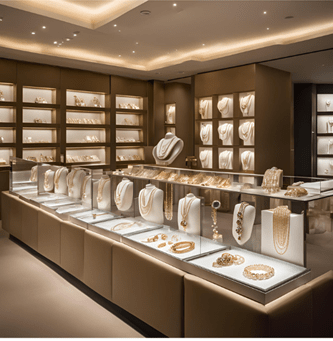In today's retail sector, personalization is the key to winning customer loyalty, especially in luxury sectors like jewellery. As customers increasingly seek unique, custom-made pieces, jewellery retailers are turning to advanced technologies like Radio Frequency Identification RFID to improve customer experiences and cater to individual preferences. RFID technology is particularly beneficial for jewellery retailers, not only in tracking inventory but also in learning customer tastes and designing personalized products. This detailed guide explores how RFID is used to create custom jewellery experiences and the benefits it offers for both retailers and customers.
What is RFID, and How Does It Work in Jewellery Retail?
RFID stands for Radio Frequency Identification, a technology that uses electromagnetic waves to identify and track items without needing direct contact. In a jewellery store, each piece can be fitted with a small RFID tag containing vital details such as product name, design, and price. These tags send data to nearby RFID readers, devices that can automatically "scan" these tags to process their information quickly. This allows the store to keep accurate, real-time records of each item, making inventory checks faster and more precise. Besides inventory management, RFID data also helps retailers analyze which pieces customers prefer, helping them personalize recommendations and designs according to individual tastes.

Why Jewellery Retailers are Adopting RFID?
The adoption of RFID in jewellery retail is growing because it helps solve two major challenges:
-
Inventory Management :
Traditional inventory tracking methods can be labour-intensive and prone to error, especially for high-value items like jewellery. RFID offers a fast, accurate, and automated way of tracking each item, reducing the chances of theft and ensuring quick updates to inventory levels.
-
Customer Personalization :
Beyond inventory, RFID can capture data about customer preferences. By understanding which items a customer frequently views or tries on, retailers can identify their tastes and suggest similar or complementary pieces. This helps in creating a tailored shopping experience.
How RFID Enhances Customer Experiences in Jewellery Retail
-
Tracking Customer Preferences :
When a customer tries on a piece of jewellery with an RFID tag, the system can log this interaction. Over time, the retailer gathers valuable data on customer preferences—such as favoured styles, metals, or gemstones.This information helps the store recommend items that match a customer’s unique tastes.
-
Offering Bespoke Recommendations :
With RFID data, retailers can analyze customer preferences to suggest pieces that align with individual tastes. For instance, if a customer frequently tries on gold earrings with diamonds, the retailer can recommend similar designs during their next visit or send personalized suggestions to their phone. This level of personalization helps customers feel understood and valued.
-
Utilizing RFID Data for Trend Analysis :
RFID data helps retailers identify popular customer preferences and stock designs that align with these trends. For example, if the system shows a consistent interest in temple jewellery, the store can introduce more unique and varied designs within this style to meet customer demand. By aligning inventory with current customer preferences, retailers can offer a selection that resonates more with shoppers, boosting sales.
-
Enabling a Sophisticated In-Store Experience :
RFID makes the shopping process smoother by reducing the need for manual intervention. For example, RFID-enabled smart trays show jewellery details like weight , price , design type ,etc directly on a screen when items are placed in it, enabling customers to explore options and specifics on their own. Additionally, if a customer requests a specific design, staff can quickly check the RFID-enabled inventory database to locate the exact piece and inform the customer about its availability or location in the store.
Advanced Uses of RFID for a Custom Jewellery Experience
-
Virtual Fitting and Augmented Reality (AR) :
With AR combined with RFID, customers can virtually try on various jewellery designs.When a customer picks up an RFID-tagged piece, the AR system identifies it and displays a virtual overlay, showing how the jewellery would look when worn. This is especially helpful for customizable designs, as customers can see variations in metals, gemstones, or styles, giving them a realistic sense of the final product—even for items not physically available in-store. This fusion of technology allows customers to explore unique combinations, helping them make confident choices.
-
Streamlined Maintenance and Servicing :
RFID can help track the servicing history of valuable or delicate jewellery. For example, tags can store information on when a piece was last cleaned, repaired, or appraised, allowing staff to proactively suggest maintenance.
-
Personalized Marketing and Loyalty Programs :
RFID data enables targeted marketing by identifying customer preferences. Retailers can send personalized promotions or exclusive offers directly to customers based on their past interactions, improvingloyalty and driving return visits.
-
Customer Journey Mapping :
RFID allows retailers to analyze the journey of customers within the store. For instance, tracking which items were picked up frequently but not purchased can provide insights, helping retailers optimize displays or offer discounts on specific pieces to encourage sales.
Benefits of RFID for jewellery retailers :
-
Improved Inventory Management :
RFID allows for real-time tracking of inventory levels, helping retailers maintain optimal stock levels and reduce the chances of overstocking or stockouts.
-
Security :
RFID technology improves security by enabling automated monitoring of high-value items. Retailers can set up alerts for unauthorized movements or attempts to remove jewellery from designated areas.
-
Better Customer Experience :
RFID improves the shopping experience by providing customers with instant access to product information through smart displays and trays , Virtual fittings , etc
-
Data-Driven Insights :
RFID provides valuable data on customer preferences and buying patterns. Retailers can analyze this data to make informed decisions about inventory, marketing strategies, and new product development.
-
Limited edition :
Retailers can use RFID data to track trends and customer preferences, enabling them to create limited-edition collections or personalized designs that cater to current demands.
-
Faster Checkout Process :
RFID technology can speed up the checkout process by allowing for quicker scanning of multiple items, reducing wait times for customers.
Conclusion :
Using RFID technology in jewellery retail is changing how stores connect with customers and manage their products. By making shopping easier and more personal, RFID helps retailers understand what customers like, improve inventory management, and security. As shoppers increasingly look for unique and customized pieces, RFID provides important insights that allow stores to create special designs and limited-edition collections. Features like virtual fittings and smart displays make the shopping experience more interactive and enjoyable. Overall, adopting RFID is not just about being efficient; it’s about building strong relationships with customers and encouraging their loyalty.
